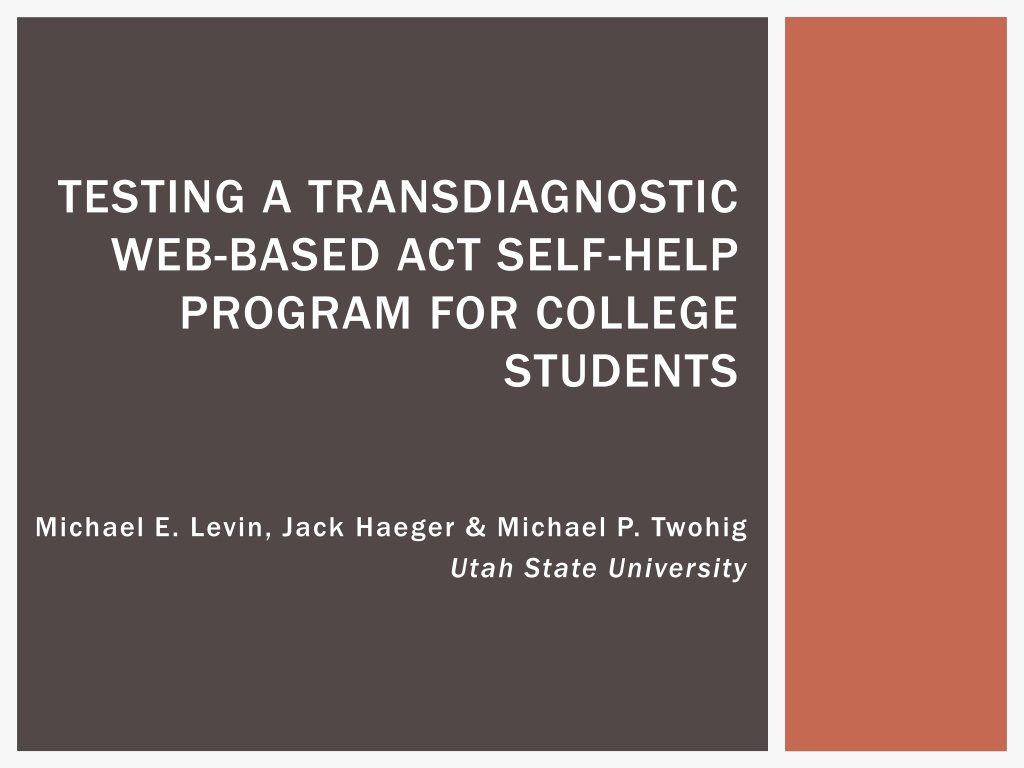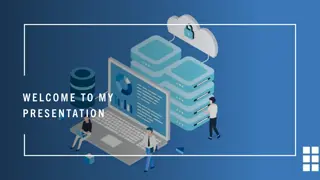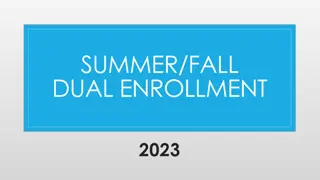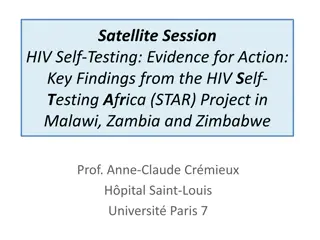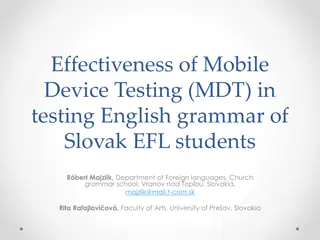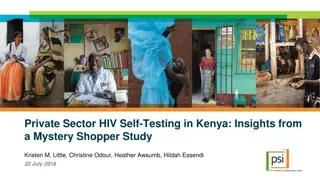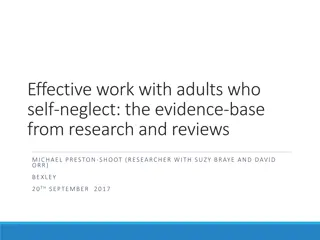Testing a Transdiagnostic Web-Based ACT Self-Help Program for College Students
Mental health challenges are prevalent among college students, leading to an increasing demand for services. A transdiagnostic web-based self-help program, utilizing Acceptance and Commitment Therapy (ACT), is being developed and tested to improve reach and access while reducing the burden on counseling centers. The program aims to target a range of disorders with a single approach, addressing psychological inflexibility effectively. Initial testing involves recruiting distressed college students to assess the program's acceptability and impact on psychological outcomes.
Download Presentation

Please find below an Image/Link to download the presentation.
The content on the website is provided AS IS for your information and personal use only. It may not be sold, licensed, or shared on other websites without obtaining consent from the author. Download presentation by click this link. If you encounter any issues during the download, it is possible that the publisher has removed the file from their server.
E N D
Presentation Transcript
TESTING A TRANSDIAGNOSTIC WEB-BASED ACT SELF-HELP PROGRAM FOR COLLEGE STUDENTS Michael E. Levin, Jack Haeger & Michael P. Twohig Utah State University
Mental Health Challenges in the College Population Mental health problems are prevalent and costly among college students Many campuses are struggling to keep up with rapid increases in demand for services And many students still don t seek treatment Self-help websites can Increase reach and access Reduce the burden on counseling centers with a low cost solution
ACT AS A TRANSDIAGNOSTIC WEB-BASED SELF-HELP APPROACH But there are challenges to matching students to self-help websites for specific problems A transdiagnostic self-help program could target a range of disorders with a single program ACT is a promising transdiagnostic approach Psychological inflexibility is related to a range of problems ACT is effective at treating a range of problems ACT outcomes are mediated by reducing inflexibility
CURRENT PROJECT Testing a web-based self-help program for distressed college students RCT design relative to a waitlist condition Using a new prototyping method Is the web-based self-help program acceptable to college students? Does it impact a range of psychological outcomes relevant to students? Does it impact outcomes by targeting key processes of change?
PARTICIPANTS 79 college students were recruited Eligibility criteria 18 or older Self-identified as being in distress and interested in web-based self-help Demographics 66% female , Age (M = 20.51, SD = 2.73) Primarily Caucasian race (88%) Distress rates 87% at least mildly severe scores on one or more CCAPS scale 68% clinically significant scores on one or more CCAPS scale 45% depression, 40% social anxiety, 30% general anxiety, 30% eating problems, 24% academic concerns, 22% hostility, 14% alcohol problems
SPRING 2015 SEMESTER PARTICIPANTS 86% said main reason for participating was for extra credit 14% participated primarily for help with a psychological problem or both help and credit 67% agreed with the statement I am interested in using the self-help website being tested in this study 29% were ambivalent saying neither agree nor disagree Where they learned about the study 86% from the SONA research platform website Only one participant from counseling or student health centers
PROCEDURES CCAPS: Depression Social Anxiety General Anxiety Academic Concerns Eating Problems Alcohol Problems 79 Students recruited Online baseline survey Randomly assigned to MHC-SF: Positive Mental Health ACT website for 4 weeks (n = 40) Waitlist for 4 weeks (n = 39) Process Measures AAQ-II: Psychological Inflexibility CFQ: Cognitive Fusion PHLMS: Acceptance and Awareness subscales VQ: Obstacles and Progress Post Assessment: Completed by n = 62, 78%
DEVELOPMENT STRATEGY Using existing content management systems (CMS) can Increase speed and efficiency of development Reduce costs significantly Provide unique features and widgets Increase platform stability But many CMS do not provide database integration Survey platforms like qualtrics do
USING QUALTRICS TO BUILD PROTOTYPES Interactive options Multiple choice, checkboxes, matrix tables, etc Fill in the blank, forms, essays, etc.. Drag and drop tools Rank order Sliders Heat maps File upload Timers Video and audio file embedding File download
USING QUALTRICS TO BUILD PROTOTYPES Features Formatting look and feel for font, images, buttons, background, etc Carry forward of data Skip logic and branching Randomization Email triggers Stability and cross platform consistency managed by qualtrics Mobile phone compatibility HTML code (expand/collapse, etc ) Database Completion of sessions Can track time on any page User responses to any exercise
CONTENT DEVELOPMENT QUESTIONS How long should the sessions be? 30-45 minutes How many sessions should we have? 6 sessions Should we tunnel vs. use an open browsing format? Sessions were tunneled and sequential, but with no wait between Take a general ACT training approach or tailor content for specific problems? General approach with content But with expandable examples illustrating with specific problems How much coaching/guidance should we provide? Minimal reminder emails and calls but no other guidance/coaching to use the program
PROGRAM USAGE/SATISFACTION Completion rates 83% completed the first session 75% completed half or more of the program Only 55% completed all six sessions Time in the program Total time in program: M = 74 minutes, SD = 83 minutes Average time in a session: M = 17 minutes, SD = 16 minutes System Usability Scale: M = 71.13, SD = 16.78 In the Good range (Bangor, 2008)
MENTAL HEALTH OUTCOMES Time by condition interactions showed improvements in ACT vs. waitlist for: CCAPS total distress, F = 6.59, p = .013, d = .66 CCAPS depression, F = 4.20, p = .045, d = .52 CCAPS social anxiety, F = 8.43, p = .005, d = .75 CCAPS academic concern, F = 5.75, p = .020, d = .62 MHC Positive mental health, F = 4.28, p = .043, d = .53 CCAPS general anxiety, F = 3.27, p = .076, d = .46 No effects on CCAPS eating concerns, hostility, or alcohol subscales (p > .10)
PROCESSES OF CHANGE Time by condition interactions showed improvements in ACT vs. waitlist for: PHLMS Acceptance, F = 4.50, p = .04, d = .52 VQ Obstruction, F = 6.38, p = .04, d = .62 No effects on AAQ-II, CFQ, PHLMS awareness, or VQ progress (p > .10)
MEDIATION ANALYSES-VQ OBSTRUCTION Significant full mediation of total distress, depression, general anxiety, and positive mental health Partial mediation for social anxiety Proportion mediated ranging from 27% to 56% a path a path X X - - M M b b path path M(X) M(X) - - Y Y c c path path X X - - Y Y c path c path X(M) X(M) - - Y Y 95% CI 95% CI Proportion Proportion mediated mediated 2.70*** 2.70*** 3.80*** 3.80*** 2.43* 2.43* 1.26 1.26 .05, .05, .37 .37 48% 48% Total Distress Depression General Anxiety Social Anxiety Academic distress Positive MH 2.73*** 2.73*** 3.77*** 3.77*** 2.13* 2.13* .94 .94 .06, .50 .06, .50 56% 56% 2.63* 2.63* 3.05** 3.05** 1.94 1.94 .96 .96 .04, .39 .04, .39 51% 51% 2.61* 2.61* 2.69** 2.69** 3.29** 3.29** 2.39* 2.39* .03, .31 .03, .31 27% 27% 2.71** 1.13 1.79 1.31 -.05, .26 2.38* 2.38* 3.28** 3.28** 2.01* 2.01* 1.09 1.09 .32, 5.99 .32, 5.99 46% 46%
MEDIATION ANALYSES-PHLMS ACCEPTANCE Significant full mediation of total distress, depression, and general anxiety Partial mediation for social anxiety Proportion mediated ranging from 17% to 40% a path a path X X - - M M b b path path M(X) M(X) - - Y Y c c path path X X - - Y Y c path c path X(M) X(M) - - Y Y 95% CI 95% CI Proportio Proportio n n mediated mediated 1.90 1.90 3.73*** 3.73*** 2.34* 2.34* 1.60 1.60 .003, .003, .33 .33 32% 32% Total Distress Depression General Anxiety Social Anxiety Academic distress Positive MH 1.87 1.87 3.78*** 3.78*** 1.92 1.92 1.16 1.16 .001, .41 .001, .41 40% 40% 1.85 1.85 3.01** 3.01** 1.78 1.78 1.13 1.13 .01, .01, .36 .36 37% 37% 1.84 1.84 2.34* 2.34* 3.19** 3.19** 2.66* 2.66* .01, .24 .01, .24 17% 17% 1.81 .50 1.85 1.67 -.08, .16 1.80 1.80 1.42 1.42 1.92 1.92 1.56 1.56 - -.10, .10, 3.79 3.79
WHAT DID YOU LIKE LEAST ABOUT THE PROGRAM? 60% said it was too long and/or too repetitive 17% said each session was too long 7% said reading segments were too long 7% did not have the time or privacy to use the program 7% emphasized inadequate coverage of certain mental health problems Only 3% reported not liking the web-based format for self-help
KEY FINDINGS Adequate usability/satisfaction ratings with the qualtrics prototype Though not as high as we would want for a high quality website May have been affected by the recruitment methods and sample Improvements on depression, anxiety, academic concerns, and positive mental health Lack of improvement on eating, hostility and alcohol problems Suggests challenges with transdiagnostic treatment or floor effects? Improvements in mindful acceptance and reduced disruption of valued living due to inflexibility Which fully mediated treatment effects Lack of changes on AAQ-II, CFQ, PHLMS awareness, and VQ progress Suggests weak impact on key processes? Measurement issues?
LESSONS LEARNED Developing self-help programs through a survey CMS can lead to adequate acceptability, usability and efficacy But results are weaker than hoped for on key usability, usage and process measure variables Effects might be improved by reducing length of sessions and longer reading segments Or possibly integrating guidance/coaching A general, transdiagnostic approach reduced a range of problems But did not impact outcomes largely outside of internalizing disorders There are recruitment challenges in engaging college students in web-based self-help Passive recruitment methods are unlikely to be sufficient
THANK YOU And join the ACTing in these topics and not a member yet. ACTing with Technology SIG with Technology SIG if you are interested
